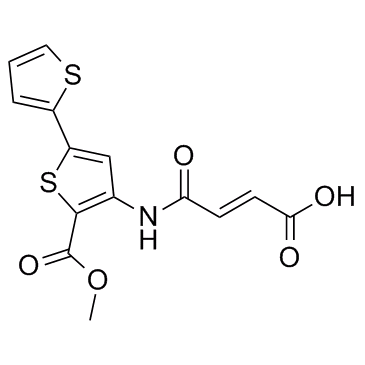HTS01037 |
| Katalog-Nr.GC31356 |
HTS01037 ist ein Inhibitor der FettsÄurebindung; und ein kompetitiver Antagonist von durch AFABP/aP2 vermittelten Protein-Protein-Wechselwirkungen mit einem Ki von 0,67 μM.
Products are for research use only. Not for human use. We do not sell to patients.

Cas No.: 682741-29-3
Sample solution is provided at 25 µL, 10mM.
HTS01037 is an inhibitor of fatty acid binding; and a competitive antagonist of protein-protein interactions mediated by AFABP/aP2 with a Ki of 0.67 μM.
HTS01037 functions as a high affinity ligand of AFABP/aP2 with an apparent Ki of 0.67 μM. HTS01037 is somewhat selective for AFABP/aP2, but at higher concentrations is a pan-specific FABP inhibitor. HTS01037 inhibits lipolysis in 3T3-L1 adipocytes and reduces LPS-stimulated inflammation in cultured macrophages. HTS01037 acts as an antagonist of the protein-protein interaction between AFABP/aP2 and hormone sensitive lipase but does not activate PPARγ in macrophage or CV-1 cells[1]. Treatment of microglial cells with HTS01037 increases expression of Ucp2 and arginase in the presence or absence of palmitic acid. Moreover, cells exposed to HTS01037 exhibits attenuated expression of inducible nitric oxide synthase (iNOS) compared to palmitic acid alone indicating reduced NFκB signaling[2]. Treatment of macrophages with HTS01037results in a marked decrease in both basal and fatty acid-stimulated LTC4 secretion but no change in 5-HETE production or 5-lipoxygenase expression[3].
[1]. Hertzel AV, et al. Identification and characterization of a small molecule inhibitor of Fatty Acid binding proteins. J Med Chem. 2009 Oct 8;52(19):6024-31. [2]. Duffy CM, et al. Identification of a fatty acid binding protein4-UCP2 axis regulating microglial mediated neuroinflammation. Mol Cell Neurosci. 2017 Apr;80:52-57. [3]. Long EK, et al. Fatty acids induce leukotriene C4 synthesis in macrophages in a fatty acid binding protein-dependent manner. Biochim Biophys Acta. 2013 Jul;1831(7):1199-207.
Average Rating: 5 (Based on Reviews and 14 reference(s) in Google Scholar.)
GLPBIO products are for RESEARCH USE ONLY. Please make sure your review or question is research based.
Required fields are marked with *




















